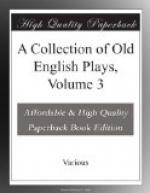INTRODUCTION TO THE DISTRACTED EMPEROR.
In the Appendix to Vol. II. I have given some account of this anonymous play, which is here printed for the first time from Egerton MS. 1994. As the play bears no title in the MS., I have named it at a venture “The Distracted Emperor.”
An ill-shaped and repulsive piece of work it certainly is; crude and cheerless, but marked with signs of unmistakable power. At the time when I made the extracts for the Appendix, I thought that Cyril Tourneur might possibly be the author. On further reflection, it seemed to me that the stronger passages are much in Marston’s manner. The horrid scene where Charlimayne is represented hugging the dead queen recalls the anonymous “Second Maiden’s Tragedy.” Marston, who shrank from nothing, would not have hesitated to show us the Archbishop, in his search for the magic ring, parting the dead queen’s lips, with the ironical observation, “You cannot byte me, Madam.” The trenchant satire that abounds throughout the play reminds us frequently of Marston, though there is an absence of that monstrous phraseology which distinguished his “Scourge of Villanie” and early plays. But, looking at the play as a whole, I should have very great hesitation in allowing it to be Marston’s. My impression is that Chapman had the chief hand in it. The author’s trick of moralising at every possible opportunity, his abundant use of similes more proper to epic than dramatic language, the absence of all womanly grace in the female characters,—these are points in which the present play may be compared with Chapman’s published tragedies. Orlando’s speech at the beginning of Act ii., “O that my curse had power to wound the starres,” &c., in which he compares himself, with epic elaboration, to “an argosie sent rychlye fourthe” and now “meanelye retourninge without mast or helm,” to my thinking closely suggests Chapman. It is not quite impossible that the present play may be Chapman’s lost “French tragedy” (entered on the Stationers’ Registers, June 29, 1660), a copy of which was among the plays destroyed by Warburton’s cook.
It is due to Mr. Fleay that I should mention his solution of the difficulty. Taking the mysterious letters on the last page, “Nella [Greek: ph d ph n r] la B,” he says: “La B. is the contraction for La Buffa,[80] one of the characters in the play; and the enigmatic letters, simply substituting the names for the letters themselves, read thus,’ Nella fi-delta fi-ni-ro la buffa,’ which is good enough Italian for an anagram, meaning ‘I will end trifling in fidelity.’ But ’Nella fedelita (or fidelita) finiro la B.’ transposed, gives us ’Il Fabro Natanielli (or Natanielle) Field,’ i.e., ‘Nathaniel Field the author’” (Athenaeum, March 3, 1883). Far be it from me to deny the ingenuity of this explanation, but when Mr. Fleay, not having seen the complete play, proceeds to say that the extracts I gave “are




